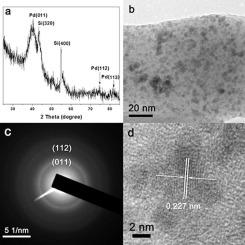Chemical Physics ( IF 2.3 ) Pub Date : 2020-05-18 , DOI: 10.1016/j.chemphys.2020.110857 Kaixiong Gao , Xiaoli Wei , Guangqiao Liu , Bin Zhang , Junyan Zhang

|
Diamond like carbon (DLC) films are considered as exciting candidates for biomaterials owing to high hardness and chemical inertness. However, the high resistivity of pure DLC films limited further applications in bioelectronic field. The palladium and phosphorus doped DLC film was fabricated by electrochemical deposition from the ethanol solution of Tetrakis (triphenylphosphine) platinum. The structure of the film was composed of CP, C
P, C
H, sp2–C, sp3–C bonds and Pd nanoparticles. The resistivity was evidently reduced due to the introduction of palladium and phosphorus, and the biocompatibility simultaneously enhanced. It will open up a new application direction for bioelectronic devices.
中文翻译:

钯和磷掺杂的非晶氢化碳膜的电沉积和生物相容性
由于高硬度和化学惰性,类金刚石碳(DLC)膜被认为是生物材料的令人兴奋的候选材料。但是,纯DLC膜的高电阻率限制了其在生物电子领域的进一步应用。钯和磷掺杂的DLC膜是通过从Tetrakis(三苯基膦)铂的乙醇溶液中进行电化学沉积制备的。薄膜的结构由C P,C
P,C
H,sp 2 -C,sp 3 -C键和Pd纳米颗粒组成。由于引入了钯和磷,电阻率明显降低,并且生物相容性同时提高。它将为生物电子设备开辟新的应用方向。



























 京公网安备 11010802027423号
京公网安备 11010802027423号